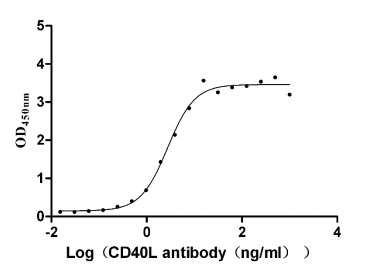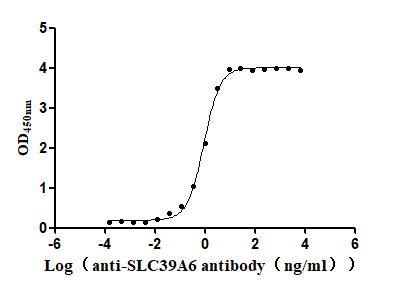Recombinant Human Selenoprotein N (SEPN1)
-
中文名称:人SELENON重组蛋白
-
货号:CSB-YP878943HU
-
规格:
-
来源:Yeast
-
其他:
-
中文名称:人SELENON重组蛋白
-
货号:CSB-EP878943HU
-
规格:
-
来源:E.coli
-
其他:
-
中文名称:人SELENON重组蛋白
-
货号:CSB-EP878943HU-B
-
规格:
-
来源:E.coli
-
共轭:Avi-tag Biotinylated
E. coli biotin ligase (BirA) is highly specific in covalently attaching biotin to the 15 amino acid AviTag peptide. This recombinant protein was biotinylated in vivo by AviTag-BirA technology, which method is BriA catalyzes amide linkage between the biotin and the specific lysine of the AviTag.
-
其他:
-
中文名称:人SELENON重组蛋白
-
货号:CSB-BP878943HU
-
规格:
-
来源:Baculovirus
-
其他:
-
中文名称:人SELENON重组蛋白
-
货号:CSB-MP878943HU
-
规格:
-
来源:Mammalian cell
-
其他:
产品详情
-
纯度:>85% (SDS-PAGE)
-
基因名:SELENON
-
Uniprot No.:
-
别名:CFTD; MDRS1; RSMD1; RSS; Selenoprotein N; Selenoprotein N, 1; SelN; SELN_HUMAN; sepn1
-
种属:Homo sapiens (Human)
-
蛋白长度:Full Length of Mature Protein
-
表达区域:44-590
-
氨基酸序列AAVRVCA RHAEAQAAAR QELALKTLGT DGLFLFSSLD TDGDMYISPE EFKPIAEKLT GSCSVTQTGV QWCSHSSLQP QLPWLNUSSC LSLLRSTPAA SCEEEELPPD PSEETLTIEA RFQPLLPETM TKSKDGFLGV SRLALSGLRN WTAAASPSAV FATRHFQPFL PPPGQELGEP WWIIPSELSM FTGYLSNNRF YPPPPKGKEV IIHRLLSMFH PRPFVKTRFA PQGAVACLTA ISDFYYTVMF RIHAEFQLSE PPDFPFWFSP AQFTGHIILS KDATHVRDFR LFVPNHRSLN VDMEWLYGAS ESSNMEVDIG YIPQMELEAT GPSVPSVILD EDGSMIDSHL PSGEPLQFVF EEIKWQQELS WEEAARRLEV AMYPFKKVSY LPFTEAFDRA KAENKLVHSI LLWGALDDQS CUGSGRTLRE TVLESSPILT LLNESFISTW SLVKELEELQ NNQENSSHQK LAGLHLEKYS FPVEMMICLP NGTVVHHINA NYFLDITSVK PEEIESNLFS FSSTFEDPST ATYMQFLKEG LRRGLPLLQP
-
蛋白标签:Tag type will be determined during the manufacturing process.
The tag type will be determined during production process. If you have specified tag type, please tell us and we will develop the specified tag preferentially. -
产品提供形式:Lyophilized powder
Note: We will preferentially ship the format that we have in stock, however, if you have any special requirement for the format, please remark your requirement when placing the order, we will prepare according to your demand. -
复溶:We recommend that this vial be briefly centrifuged prior to opening to bring the contents to the bottom. Please reconstitute protein in deionized sterile water to a concentration of 0.1-1.0 mg/mL.We recommend to add 5-50% of glycerol (final concentration) and aliquot for long-term storage at -20℃/-80℃. Our default final concentration of glycerol is 50%. Customers could use it as reference.
-
储存条件:Store at -20°C/-80°C upon receipt, aliquoting is necessary for mutiple use. Avoid repeated freeze-thaw cycles.
-
保质期:The shelf life is related to many factors, storage state, buffer ingredients, storage temperature and the stability of the protein itself.
Generally, the shelf life of liquid form is 6 months at -20°C/-80°C. The shelf life of lyophilized form is 12 months at -20°C/-80°C. -
货期:Delivery time may differ from different purchasing way or location, please kindly consult your local distributors for specific delivery time.Note: All of our proteins are default shipped with normal blue ice packs, if you request to ship with dry ice, please communicate with us in advance and extra fees will be charged.
-
注意事项:Repeated freezing and thawing is not recommended. Store working aliquots at 4°C for up to one week.
-
Datasheet :Please contact us to get it.
相关产品
靶点详情
-
功能:Plays an important role in cell protection against oxidative stress and in the regulation of redox-related calcium homeostasis. Regulates the calcium level of the ER by protecting the calcium pump ATP2A2 against the oxidoreductase ERO1A-mediated oxidative damage. Within the ER, ERO1A activity increases the concentration of H(2)O(2), which attacks the luminal thiols in ATP2A2 and thus leads to cysteinyl sulfenic acid formation (-SOH) and SEPN1 reduces the SOH back to free thiol (-SH), thus restoring ATP2A2 activity. Acts as a modulator of ryanodine receptor (RyR) activity: protects RyR from oxidation due to increased oxidative stress, or directly controls the RyR redox state, regulating the RyR-mediated calcium mobilization required for normal muscle development and differentiation.; Essential for muscle regeneration and satellite cell maintenance in skeletal muscle.
-
基因功能参考文献:
- Case Report: rigid spine muscular dystrophy 1 in a compound heterozygote with two novel mutations in SEPN1 gene; a novel missense mutation (c.1384T>C; p.Sec462Arg) and a novel nonsense mutation (c.1525C>T; p.Gln509Ter), inherited from his father and mother respectively. PMID: 27863379
- We report two previously undescribed mutations in SEPN1. Our study adds two novel homozygous mutations to the number of reported pathogenic SEPN1 variants. PMID: 26780752
- The physiological function of SelN in muscle tissue and the pathogenesis leading to SEPN1-related myopathies. [Review] PMID: 22527882
- Data show that the spectrum of severity of SEPN1-related myopathiesis wider than previously reported. PMID: 21670436
- Data show that Argonaute 2 expression is critical for stem cells to escape senescence by downregulating miR10b and miR23b, and that selenoprotein N1 is also involved in ATSC survival and self-renewal through ROS-mediated p38 MAPK inactivation. PMID: 21241449
- this series of patients illustrates the clinical, histopathological and MRI findings of SEPN1-related myopathy. It also adds new mutations to the limited number of fully described pathogenic SEPN1 variants. PMID: 20937510
- Mutations of the selenoprotein N gene, which is implicated in rigid spine muscular dystrophy, cause the classical phenotype of multiminicore disease PMID: 12192640
- A new SEPN1 point mutation, 943g->A causing G315S was found in a rigid spine muscular dystrophy patient with cor pulmonale. PMID: 15668457
- SEPN1 mutation analysis revealed that the patient was a compound heterozygote: a previously described insertion (713-714 insA), and a novel nonsense mutation (R439stop). PMID: 15792869
- Two patients with 'Dropped head syndrome' due to mutations in SEPN1 genes. PMID: 15961312
- SEPN1 is the second genetic cause of CFTD and the first cause of autosomal recessive CFTD to be identified to our knowledge. CFTD is the fourth clinicopathological presentation that can be associated with mutations in SEPN1. PMID: 16365872
- identification of this mutation affecting a conserved base in the selenocysteine insertion sequence functional motif thereby reveals the structural basis for a novel pathological mechanism leading to SEPN1-related myopathy PMID: 16498447
- We report on the possible molecular mechanism behind these mutations in SEPN1. Our study clarifies molecular mechanisms of this muscular disorder. PMID: 16779558
- SEPN1 and RYR1 are required for the same cellular differentiation events and are needed for normal calcium fluxes PMID: 18713863
- Data highlights the importance of the SRE element during SelN expression and illustrates a novel molecular mechanism by which point mutations may lead to SEPN1-related myopathy. PMID: 19067361
- SelN plays a key role in redox homeostasis and human cell protection against oxidative stress. PMID: 19557870
- The Alu-derived exon 3 of human SEPN1 acquired its muscle-specific splicing activity after the divergence of humans and chimpanzees, suggesting its potential role in human evolution. PMID: 18841251
显示更多
收起更多
-
相关疾病:Rigid spine muscular dystrophy 1 (RSMD1); Myopathy, congenital, with fiber-type disproportion (CFTD)
-
亚细胞定位:[Isoform 2]: Endoplasmic reticulum membrane.
-
组织特异性:Isoform 1 and isoform 2 are expressed in skeletal muscle, brain, lung and placenta. Isoform 2 is also expressed in heart, diaphragm and stomach.
-
数据库链接:
HGNC: 15999
OMIM: 255310
KEGG: hsa:57190
STRING: 9606.ENSP00000355141
UniGene: Hs.323396
Most popular with customers
-
Recombinant Human CD40 ligand (CD40LG), partial (Active)
Express system: Mammalian cell
Species: Homo sapiens (Human)
-
Recombinant Mouse Prolactin receptor (Prlr), partial (Active)
Express system: Mammalian cell
Species: Mus musculus (Mouse)
-
Recombinant Human Carcinoembryonic antigen-related cell adhesion molecule 8(CEACAM8) (Active)
Express system: Mammalian cell
Species: Homo sapiens (Human)
-
Recombinant Human CD70 antigen (CD70), partial (Active)
Express system: Mammalian cell
Species: Homo sapiens (Human)
-
Recombinant Human C-C chemokine receptor type 6(CCR6)-VLPs (Active)
Express system: Mammalian cell
Species: Homo sapiens (Human)
-
Recombinant Macaca fascicularis Zinc transporter ZIP6 isoform X1(SLC39A6),partial (Active)
Express system: Baculovirus
Species: Macaca fascicularis (Crab-eating macaque) (Cynomolgus monkey)
-
Recombinant Macaca fascicularis Interleukin 1 receptor accessory protein(IL1RAP), partial (Active)
Express system: Mammalian cell
Species: Macaca fascicularis (Crab-eating macaque) (Cynomolgus monkey)



















